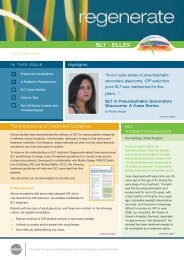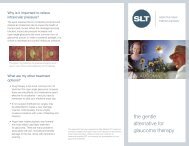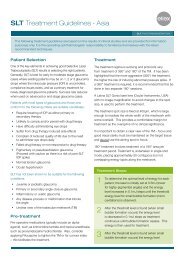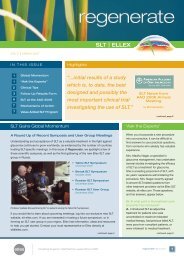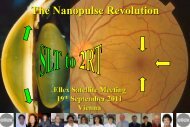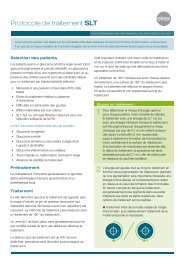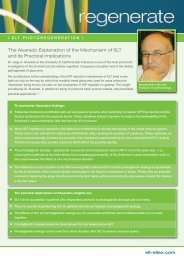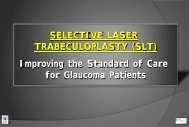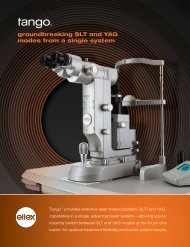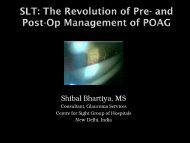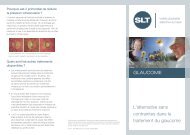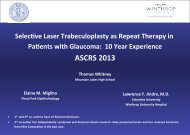Regenerate - SLT for Glaucoma | Ellex
Regenerate - SLT for Glaucoma | Ellex
Regenerate - SLT for Glaucoma | Ellex
- No tags were found...
You also want an ePaper? Increase the reach of your titles
YUMPU automatically turns print PDFs into web optimized ePapers that Google loves.
<strong>SLT</strong> ELLEXFROMVOL 9 I MARCH 2009IN THIS ISSUE Highlights1124685-Year Study Results<strong>SLT</strong> and PregnancyClinical TipsResearch RoundupPrimary vs. Adjunct Therapy<strong>SLT</strong> vs. Latanoprost• Mechanisms of <strong>SLT</strong>’s IOP-LoweringEffects• Predicting <strong>SLT</strong> Efficacy• Effects of <strong>SLT</strong> on Diurnal IOPFluctuations• Economics of <strong>Glaucoma</strong> TherapyResearchRoundup:Highlightsof RecentlyPublished<strong>SLT</strong> Studiescontinued, page 4Five-Year Results Highlight Long-Term Efficacy of <strong>SLT</strong>Analysis of a Large Patient Series Over FiveYears Highlights Long-Term Efficacy of <strong>SLT</strong>and Potential <strong>for</strong> Repeat TreatmentDuring the 2008 <strong>Ellex</strong> ESCRS <strong>SLT</strong> symposium, apresentation by Lawrence Jindra, MD focused onthe long-term efficacy of <strong>SLT</strong>. He and his colleaguesreviewed five years of retrospective data on atotal of 2,056 eyes undergoing <strong>SLT</strong> as primary,secondary or repeat treatment from January 2002through February 2007.At the symposium, Dr. Jindra reported thattreatment with <strong>SLT</strong> in this clinical series resulted in a significantly lowered intraocularpressure (IOP), significantly fewer medications and a reduced repeat rate incomparison to ALT.<strong>SLT</strong> as Primary TreatmentA total of 879 eyes in this series underwent <strong>SLT</strong> as a primary glaucoma treatment.Among those eyes, there was a 31 percent mean reduction in IOP, which decreasedfrom a mean of 19.1 mmHg to 13.2 mmHg. Throughout the study, 93 percent of theseeyes required no glaucoma medication or repeat <strong>SLT</strong> treatment.These primary data appear very good; however, as Dr Jindra pointed out at thesymposium, practitioners must bear in mind that although these patients have been<strong>SLT</strong>: Safe and Effective<strong>for</strong> Pregnant andLactating WomenJung-II Moon, MD, PhD, South Korea<strong>Glaucoma</strong> treatment considerations <strong>for</strong>a pregnant or lactating patient can becomplicated. All of the drugs used <strong>for</strong>glaucoma are absorbed by the body,cross the placenta, and are excretedin breast milk. Due to the potential <strong>for</strong>side effects to the fetus and the infant,the safest option would be to avoid allglaucoma medications altogether and opt<strong>for</strong> a medication-free alternative treatmentto reduce intraocular pressure (IOP).This need <strong>for</strong> a safe alternative is what ledDoctors Jung-Il Moon and Myoung HeePark from the Catholic University of Korea,Seoul College of Medicine to investigatethe efficacy and safety of <strong>SLT</strong> in pregnantand lactating women. Specifically,their investigation centered on patientscontinued, page 3 continued, page 5regenerate March 20091
Clinical TipsPrateep Vyas, MD, Choithram Netralaya, Indore, India<strong>Glaucoma</strong> is a chronic disease whichaffects an increasing proportionof the global population. Medicaltherapy has become the mainstaytreatment <strong>for</strong> glaucoma; however,there are a number of complianceissues and side effects associatedwith medical therapy. Selective LaserTrabeculoplasty (<strong>SLT</strong>) has emergedas a non-invasive laser technique<strong>for</strong> managing elevated intraocularpressure (IOP). Indeed, <strong>SLT</strong> hasbecome an important addition to my practice; in particular, I have found<strong>SLT</strong> to be virtually free from side effects, and it demonstrates goodefficacy in controlling elevated IOP in the majority of my glaucomapatients.<strong>SLT</strong> is Non-Thermal<strong>SLT</strong> uses a 532nm wavelength at 3 nanosecond pulse duration, andfeatures a 400 micron spot size. <strong>SLT</strong> is a non-thermal mechanism whichaffects an immunological process in the treated eye – hence, it is gentleand does not cause permanent damage to the trabecular meshwork(TM). Given this, <strong>SLT</strong> is repeatable, and does not preclude anti-glaucomasurgery – a distinct advantage over Argon Laser Trabeculoplasty (ALT).<strong>SLT</strong> as Primary TherapyThere is strong evidence to support the role of <strong>SLT</strong> as primary therapy.<strong>SLT</strong> reduces IOP by an average of 20% from baseline, and its IOPloweringeffect is long-lasting. As such, <strong>SLT</strong> is suitable as a primarytherapy <strong>for</strong> elevated IOP in patients with ocular hypertension. <strong>SLT</strong> is alsosuitable as a primary therapy option in the following situations:1. Lactating mothers2. Pregnancy3. Severe dry eye4. Where short term IOP reduction is required i.e. steroid responders(after intravitreal or sub Tenons injection).<strong>SLT</strong> as Adjunct Therapy<strong>SLT</strong> is also suitable as an adjunct therapy <strong>for</strong> the following patients:1. Patients on multiple anti-glaucoma medication suffering frominadequate IOP control2. Patients with systemic CAI; Note: <strong>SLT</strong> can assist in the removal ofsystemic CAI3. Patients with inadequate control of IOP in need of surgery4. Patients suffering from poor compliance and intolerance tomedication.2regenerate March 2009<strong>SLT</strong> Clinical TipsUse the lowest energy setting neededin order to release champagnebubbles; start at 0.6-0.8 mJ and titrateupwards or downwards, as required.In order to prevent post-proceduralIOP spike, always administer mioticsand a tab of Diamox 250mg one-hourprior to treatment.Use a Latina lens due to its zeromagnification.Apply 50 spots over 180-degrees ofthe trabecular meshwork (TM); apply100 spots over 360-degrees of theTM.Note: it is possible to per<strong>for</strong>m 360-degree treatment in one sitting, butalways apply topical NSAID postproceduree.g. Acular LS tid <strong>for</strong> threedays, in order to prevent IOP spike.A heavily pigmented TM requires lessenergy. Take care not to confusepigmentation of Schwalbe’s line withpigmentation of the TM.Focus the treatment beam over thefull height of the TM in order to achieveoptimal results.Check IOP post procedure at onehourand four-hour intervals, at day3 and 7, at week 4 and week 14,followed by quarterly check-ups.Note: approximately 20 percent ofpatients experience an IOP spikefollowing the procedure.When per<strong>for</strong>ming repeat <strong>SLT</strong>, do nottreat the same area of the TM within 12months of initial treatment.Wait one month in order to evaluatetreatment per<strong>for</strong>mance; if target IOP isnot achieved, continue anti-glaucomamedication.
Five-Year Results Highlight Long-Term Efficacy of <strong>SLT</strong>, continued from page 1This retrospective analysis showsthat after <strong>SLT</strong>, 86 percent of eyesthat had previously been on onemedication no longer requiredmedication over the five yearperiod. Among eyes that wereon two medications, 62 percentrequired no medication. Amongthe eyes that underwent <strong>SLT</strong> assecondary treatment, one out ofthree patients (32 percent) that wereon four medications (dorzolamidehydrochloride, timolol maleate,latanoprost, and brimonidinetartrate) pre-<strong>SLT</strong> were able to stoptaking all medications and have IOPin goal.<strong>Ellex</strong> <strong>SLT</strong> symposium: ESCRS delegates take part in discussion on <strong>SLT</strong>.diagnosed with glaucoma or the risk of glaucoma, many ofthese eyes were not yet ‘sick.’ Instead, these were previouslyuntreated eyes that were being exposed to their first glaucomatreatment.Today, initial treatment occurs at IOP levels that weregenerally not treated five or 10 years ago, due in large partto what has been learned about early and effective treatmentfrom controlled clinical trials. This includes data from newtechnologies like nerve fiber layer and blood flow analyzers,which enable earlier diagnosis and closer tracking of diseaseand treatment progress. In addition, newly emerging consensusand patterns of thought in glaucoma treatment paradigms havealso had an influence.<strong>SLT</strong> as Secondary TreatmentA significant number of glaucoma patients among the entireclinical series were referred to Dr. Jindra because their IOP wasnot successfully controlled by medications and/or because theycould not tolerate the systemic and/or local side effects of theirglaucoma treatment regimen.In this arm of the study, 760 eyes underwent <strong>SLT</strong> assecondary treatment <strong>for</strong> glaucoma. IOP decreased from amean of 20 mmHg to 15.9 mmHg over the five-year period,which represented a 21 percent mean reduction in IOP. Afterundergoing <strong>SLT</strong>, the number of medications <strong>for</strong> these eyesdecreased from a mean of 2.3 to 1.3, which represented a 44percent mean reduction in the number of medications requiredover the five-year study.While these data are in some waysless impressive than that of theprimary therapy arm of the study,it is noteworthy that the meanreduction of IOP was greater than 20 percent. In addition,these data showed that after <strong>SLT</strong>, more than three-quarters (77percent) of these eyes did not require medication to control IOPand keep it in goal.A small portion of eyes (376 out of 1634) that were initiallytreated with <strong>SLT</strong> and were referred to Dr. Jindra <strong>for</strong> IOP controland/or reduction in side effects required repeat <strong>SLT</strong> treatment.The incidence of repeat <strong>SLT</strong> was 11 percent of eyes treatedover three years, 18 percent of eyes treated over four years,and 24 percent of eyes treated over five years.Even with more robust re-treatment criteria than those used<strong>for</strong> ALT (local and systemic side effects, compliance issues,desire to decrease or eliminate medications), <strong>SLT</strong> failure ratescompare favorably to that of ALT, which have been previouslyreported at approximately 30 percent failure at three years, with10 percent failure per year thereafter.Dr. Jindra is a glaucoma specialist in privatepractice in Floral Park, New York; Chief of theDivision of Ophthalmology at Winthrop UniversityHospital in Mineola, New York; and an AssistantClinical Professor of Ophthalmology at ColumbiaUniversity in New York City.The data presented at the <strong>Ellex</strong> ESCRS <strong>SLT</strong>symposium were previously presented atASCRS, ARVO, and AAO in 2008.regenerate March 20093
Research Roundup: Highlights of Recently Published <strong>SLT</strong> StudiesMichael Belkin, MA, MD, Professor of OphthalmologyEditor’s Comments: A constant flow of new research regarding <strong>SLT</strong> is evidence of increased interest in the treatment,which has proven to be efficacious as adjunct therapy to medication, and has also evolved to become a first-line treatmentoption <strong>for</strong> glaucoma patients. The following synopsis of recent research includes the mechanism of IOP reduction by lasertrabeculoplasty, whether or not the efficacy of <strong>SLT</strong> can be predicted, the effects of <strong>SLT</strong> on diurnal IOP fluctuations, and theeconomics of glaucoma therapy.Mechanisms of <strong>SLT</strong>’s IOP-Lowering EffectsIn an article expounding on the use of stem cells to treat the trabecular deficiency that causesdecrease in aqueous outflow, Kelley at al. (Exp. Eye Res, advanced online publications)suggest a novel theory <strong>for</strong> the mechanism of IOP reduction by laser trabeculoplasty (LTP).This study is based on the work of Raviola in 1982, who described a cell in the anteriortrabeculum that was later thought of as a local stem cell, as well as later evidence that ALTincreases cell division in that area. The study suggests that LTP increases stem cell activity inthe trabeculum, which leads to restoration of cellularity and function. Although similar studieswere not per<strong>for</strong>med with <strong>SLT</strong>, increasing stem cell replication might indeed be one of themechanisms whereby LTP reduces intraocular pressure (IOP).Activation of local stem cells, even if factual, cannot explain the total effect of LTP. Support<strong>for</strong> a previously known mechanism of action is provided by Rhodes, et al (Curr. Med. Res.Opinion, 2009;25:787). This study retrospectively examined the IOP changes in the eye thatunderwent <strong>SLT</strong> and in the fellow eye of 43 patients with relatively low pre-operative IOP.In the fellow eyes, mean IOP reduction declined by 11.2 percent (2.1 + 0.5 mmHg), as compared to the treated eye, where themean reduction was 18.8 percent (3.9 + 0.6 mmHg). This is probably due to the various cytokines and growth factors releasedfrom the treated eye. These molecules are secreted in the treated eye in large enough quantities to enter the bloodstream, beenormously diluted, and still arrive at the other eye in sufficient quantity to lower IOP.We see the same effect on the other eye with anti-hypertensive eye drops. As in all trials, the extent of IOP reduction was directlyrelated to the pre-treatment level and, in this study, also to the number of glaucoma medications used. There was no significantdifference in IOP reduction in either eye according to age, gender, central corneal thickness, extent of treatment, or lens status.Predicting <strong>SLT</strong> EfficacyContrary to some preconceptions, prior treatment with prostaglandin analogs has no effect on the extent of IOP reduction inducedby <strong>SLT</strong>. This was shown by Singh et al. (Eye Advance online publication, 30 January 2009) who carried out a retrospective studyon 123 consecutive patients who underwent 180-degree <strong>SLT</strong> <strong>for</strong> the first time.Of these, 74 received prostaglandin analogs with or without other anti-hypertensive eye drops chronically. The pre-<strong>SLT</strong> drugtherapy of the rest did not include prostaglandin analogs. There was no difference in IOP reduction during the short- and longtermfollow up (3.9 ± 4.8 vs4.6 ± 3.6 mm Hg, P=0.43).The study by Mao et al. (J <strong>Glaucoma</strong> 2008;17:449–454) was based on 220 patients followed over six months. It showed that <strong>SLT</strong>efficacy is positively related to IOP level prior to treatment. Like many other studies, the pre-<strong>SLT</strong> level was shown to be the mostimportant factor in determining <strong>SLT</strong> efficacy. What is new in this article is that the degree of IOP reduction is inversely related tothe maximum IOP ever recorded <strong>for</strong> the patient. Interestingly, pigmentation of the trabecular meshwork (TM), the precise type ofglaucoma and washout of eye drops be<strong>for</strong>e <strong>SLT</strong> were unrelated to the results.Effects of <strong>SLT</strong> on Diurnal IOP FluctuationsNagar et al. (BJO Online First, December 23, 2008) found that prostaglandins reduced the amplitude of the diurnal variationsof IOP somewhat better than <strong>SLT</strong> in a six-month study, during which the diurnal curve in 40 patients was measured toward the4regenerate March 2009
<strong>SLT</strong>: Safe and Effective <strong>for</strong> Pregnant and Lactating Women, continued from page 1Jung-II Moon, MD, PhD, St. Mary’s Hospital, The Catholic University of Korea, South Koreawho have primary open-angle glaucoma (POAG) and ocularhypertension (OH) 1 . <strong>Regenerate</strong> recently interviewed Jung-Il Moonto discuss and analyze the findings of the investigation.Question: How many pregnant or lactating patients withPOAG or OH have you been able to follow up on?Jung-Il Moon: We per<strong>for</strong>med a study on 22 patients (40 eyes) ofprimary open-angle glaucoma (40 eyes) and ocular hypertension(10 eyes).Question: How did you follow up on these patients?Jung-Il Moon: We followed the recommended <strong>SLT</strong> follow-upprocedure and measured IOP at one hour, one day, one week,one month, three months, and six months after treatment.Anterior chamber reaction and ocular pain were checked onpost-operative day one. Peripheral anterior synechia wasexamined at post-operative six months. Any anti-glaucoma drugwas discontinued after the <strong>SLT</strong> procedure, and restarted whenneeded.Question: Were the results encouraging?Jung-Il Moon: Absolutely. The mean IOP after using antiglaucomamedication was 15.7 mmHg (the mean baselineintraocular pressure was 31.6 mmHg) and the mean numberof anti-glaucoma drug was 1.3 ± 0.6 pre-operatively. After the<strong>SLT</strong> treatment, post-operative IOP decrease was 17.9 mmHg atone day, 16.3 mmHg at one week, 17.7 mmHg at one month,18.4 mmHg at three months and 19.0 mmHg at six months. Themean number of anti-glaucoma drug was reduced to 0.43 ± 0.7(p=0.000) post-operatively.Question: Did you observe any significant post-operativecomplications during the six-month period of follow up?Jung-Il Moon: No, not at all. Anterior chamber reaction, transientIOP spike and ocular pain were checked on some patients onpost-operative day one.But these symptomswere transient anddisappeared over time.There were no seriouscomplications (includingPAS) in any of thepatients during the sixmonths following <strong>SLT</strong>.Question: Since thisstudy, have you hadthe opportunity totreat other pregnantor lactating patientswith POAG or OH, anddid the results confirm the findings of your study?Jung-Il Moon: I have recently treated not only pregnant orlactating patients, but also patients who are engaged orwho have a possibility of pregnancy. They are asking <strong>for</strong><strong>SLT</strong> treatment because they are concerned about glaucomamedications and their side effects.Question: Would you then say that priority shouldbe given to <strong>SLT</strong> when looking <strong>for</strong> a medication-freealternative treatment in pregnant and lactating womenwho have POAG and OH?Jung-Il Moon: <strong>SLT</strong> has proven to be a safe and effectiveprocedure <strong>for</strong> fertile female patients who need to discontinueor reduce anti-glaucoma drugs. The treatment seemsparticularly appropriate <strong>for</strong> these indications.References:1.“Selective Laser Trabeculoplasty in Fertile Women with Open Angle<strong>Glaucoma</strong> or Ocular Hypertension”, Myoung Hee Park, M.D., Jung-Il Moon, M.D., J Korean Ophthalmol Soc 48(11):1494-1499, 2007.Research Roundup, continued from page 4Michael Belkin, MA, MD, Professor of Ophthalmologyend of the period (3.6 mmHg, vs. 2.5 mmHg, p=0.04). However, this study did not measure compliance, the very likely deficiencyof which is bound to produce diurnal and long-term IOP fluctuations. The extent of IOP reduction didn't differ between those whoreceived prostaglandins and those who underwent <strong>SLT</strong>.Economics of <strong>Glaucoma</strong> TherapyCantor et al. (Curr. Med. Res. Opinion 2008,24:2905) compared the five-year costs of three treatment strategies in managing POAGpatients not adequately controlled with two medications. These strategies were continued medication, laser trabeculoplasty, andfiltering surgeries. Using the Markov model, the authors showed that laser trabeculoplasty is associated with the lowest costs oftreatment over five years, as compared to medication alone and filtering surgery.regenerate March 20095
Efficacy of <strong>SLT</strong> in Ocular Hypertension and Primary Open-Angle <strong>Glaucoma</strong>:Primary Treatment Vs. Adjunct TreatmentPrimary Tarek Eid, Treatment MD, Associate vs. Adjunctive Professor of Therapy Ophthalmology, Tanta University, EgyptSelective lasertrabeculoplasty (<strong>SLT</strong>)has been gaining wideracceptance since itsintroduction in 1995 byLatina & Park 1 . Clinicalstudies suggest <strong>SLT</strong> isefficacious in lowering IOP,either as initial treatmentor when used adjunctive tomedical therapy. Responserates after one year rangefrom 59-96 percent, withaverage IOP reductionfrom 18-40 percent 2-4 .Dr. Tarek M. Eid, assistant professor at the Magrabi Eye & EarCenter in Jeddah, Saudi Arabia, has just completed a study todetermine the IOP-lowering effect of <strong>SLT</strong> when used as initialtreatment or as adjunctive therapy <strong>for</strong> primary open-angleglaucoma (POAG) or ocular hypertension (OH). The followingare his findings and observations.Patient selection and laser techniqueFor this study, patients were classified into two groups. The firstgroup included newly diagnosed eyes with POAG or OH, andthe second included patients diagnosed with POAG or OH andcurrently on medical treatment with or without previous ALTtreatment.All patients received one drop of brimonidine immediatelybe<strong>for</strong>e the laser treatment to prevent post-operative pressurespikes. All eyes had surface anesthesia immediately be<strong>for</strong>e theprocedure.The patient was com<strong>for</strong>tably seated on the slit lamp chair anda Goldmann 3-mirror lens was inserted in the eye coupled withviscoelastic. The gonioscopic mirror of the lens was rotated toview the inferior angle. The aiming beam was focused on thetrabecular meshwork (TM) and a single 400µm spot with 0.8mJpower was delivered at the 12 o’clock position. The power wasincreased or decreased by 0.1mJ according to the absence orpresence of cavitation bubbles.The end point is maximum energy beyond which a bubbleappears in the TM.The procedure was then continued at this energy level withadjacent but non-overlapping laser spots. Throughout theprocedure, bubble <strong>for</strong>mation was monitored with each pulseand energy level was adjusted as described be<strong>for</strong>e. Thetreatment plan was variable, with most of the eyes receiving270-degree or 360-degree treatment, with the average numberof shots ranging between 75 and 100.All eyes received non-steroidal anti-inflammatory drops everysix hours <strong>for</strong> five days. Patients were examined after one day,one week, one month, three months, and periodically everythree months. Withdrawal or addition of anti-glaucoma dropsor repetition of laser treatment in either group was per<strong>for</strong>medaccording to the IOP level throughout the follow-up period.ResultsThe study included 27 eyes of 15 patients in the primarytreatment group (Group 1) and 45 eyes of 28 patients in theadjunctive treatment group (Group 2). Sixteen eyes (59.3percent) in Group 1 and 39 eyes (86.7 percent) in Group 2 haddiagnosis of POAG. Most of the eyes in Group 2 (77.7 percent)were using one or two anti-glaucoma medications.Laser treatment was confined to three or four quadrants ofangle circumference. Baseline IOP was significantly higher inGroup 1 (24.8 + 3.5 mmHg) than Group 2 (18.4 + 3.6 mmHg)(p
Dr. Tarek Eid will take part in the <strong>Ellex</strong><strong>SLT</strong> Symposium during MEACO on28 March 2009 in Manama, Bahrain.Table 1:VariablePrimary TreatmentGroup (n=27)Adjunctive TreatmentGroup (n=45)Mean + SD Mean + SD P-valuePre-laser IOP (mmHg) 24.8 + 3.5 18.4 + 3.6 20 percent IOPlowering as adjunctive treatment in glaucoma patientsreceiving medications may be attributed primarily to the lowbaseline IOP, number and type of glaucoma medicationsused, and glaucoma severity. In the adjunctive treatmentgroup in our study, 75.6 percent of eyes had pre-<strong>SLT</strong> pressure20percent reduction of IOP at last follow-up.Hodge et al 6 used multivariate regression analysis to comparepredictive factors <strong>for</strong> success (defined as at least 20 percentdrop of IOP from pretreatment level at one-year post-<strong>SLT</strong>)in 72 patients with OAG on maximum medical therapy. <strong>SLT</strong>success was significantly predicted by baseline IOP (a higherbaseline IOP is related to a higher success) but not by age, sex,other glaucoma risk factors, type of OAG, or by degree of TMpigmentation.Conclusion<strong>SLT</strong> demonstrated greater efficacy in the reduction of IOP whenused as initial therapy <strong>for</strong> newly diagnosed eyes with OH orPOAG than when used as adjunctive therapy <strong>for</strong> eyes takinganti-glaucoma medications with low baseline IOP.References:1.2.3.4.5.6.Latina MA, Park C. Selective targeting of trabecular meshwork cells: in vitrostudies of pulsed and CW laser interactions. Exp Eye Res 1995;60:359-371Barkana Y, Belkin M. Selective laser trabeculoplasty. Surv Ophthalmol2007;52:634-654Melamed S, Ben Simon GJ, Levkovitch-Verbin H. Selective lasertrabeculoplasty as primary treatment <strong>for</strong> open-angle glaucoma: aprospective, nonrandomized pilot study. Arch Ophthalmol 2003;121:957-960McIlraith I, Strasfeld M, Colev G, Huntik CM. Selective laser trabeculoplastyas initial and adjunctive treatment <strong>for</strong> open-angle glaucoma. J <strong>Glaucoma</strong>2006;15:124-130Rachmiel R, Trope GE, Chipman ML, Gouws P, Buys YM. Lasertrabeculoplasty trends with introduction of new medical treatments andselective laser trabeculoplasty. J <strong>Glaucoma</strong> 2006;15:306-309Hodge WG, Damji KF, Rock W, Ruhrmann R, Bovel AM,, Pan Y. Baseline IOPpredicts selective laser trabeculoplasty success at 1 year post-treatment:results from a randomized clinical trial. Br J Ophthalmol 2005;89:1157-1160regenerate March 20097
Upcoming Events<strong>SLT</strong> SymposiaSTO 2009<strong>SLT</strong> Symposium14 March 2009Tunis, TunisiaMEACO 2009<strong>SLT</strong> Symposium28 March 2009Manama, BahrainRegister to attend at slt-ellex.comXXIX SymposiumRetinologicum<strong>SLT</strong> Symposium17 April 2009Gdansk, PolandSlovakia 2009<strong>SLT</strong> Symposium15 May 2009Bratislava, Slovakia<strong>Regenerate</strong> RegistrationThrough <strong>Regenerate</strong>, <strong>Ellex</strong> providesinsights on <strong>SLT</strong>, drawing on the expertiseof experienced <strong>SLT</strong> users.<strong>Regenerate</strong> is published quarterly, andcan be received via email.To subscribe, please register by:Fax: +61 8 8221 5651Email: slt@ellex.comOnline: http://slt-ellex.com/newsletter<strong>SLT</strong> Compared to Latanoprost with Respect to Diurnal IOP Fluctuation ControlJavier Benitez-del-Castillo, MD, Hospital General, SAS Jerez, SpainDoctor Javier Benitez-del-Castillo,Hospital General, SAS Jerez, Spain,and his peers 1 recently conducted aprospective case series study of 16 eyesfrom 8 patients (ocular hypertensives andglaucoma) under latanoprost monotherapy.The purpose was to compare the efficacyof <strong>SLT</strong> and latanoprost in diurnal IOPfluctuation control.The reason <strong>for</strong> the study, according toDr. Benitez-del-Castillo, was simple.“If we want to position <strong>SLT</strong> as first-linetherapy, it makes sense to compare itwith the medication that is the mostprescribed. I also chose latanoprostbecause of its similar mechanism ofaction to <strong>SLT</strong> through the activationof metaloproteinases. I then decidedto consider the diurnal IOP fluctuationcontrol of both therapies, as this can beconsidered a risk factor <strong>for</strong> progressionand/or conversion to glaucoma.”Table 1:In order to analyze and compare theefficacy of <strong>SLT</strong> and latanoprost on diurnalIOP fluctuation control, diurnal curveswere per<strong>for</strong>med in patients who underwentprostaglandin analogue treatment, andtopical medication withdrawn immediatelyfollowing 360 degree <strong>SLT</strong> treatment(see Table 1). Diurnal curves were againper<strong>for</strong>med two months post follow-up andthe data compared. Results were thenanalyzed using the Wilcoxon test <strong>for</strong> pairedsamples.With latanoprost, the median from meandiurnal IOP was 15.6 mmHg (95% CI 14.9to 16.6) and median from mean diurnal IOPpost-<strong>SLT</strong> was 16.1 mmHg (95% CI 15.6 to17). The highest mean diurnal IOP valueobtained with latanoprost was 18.3 mmHg(SD=1.5) and 18.5 mmHg with <strong>SLT</strong>.With regards to lowest mean diurnal IOPvalue, the value obtained with latanoprostwas 13.5 mmHg (SD=1.1) and 14 mmHgwith <strong>SLT</strong> (SD 1.2). Finally, the meanIOP diurnal difference obtained withlatanoprost was 4.8 mmHg (SD=2) and4.5 mmHg with <strong>SLT</strong> (SD=1.5).According to Dr. Benitez-del-Castillo,“There is no statistically significantdifference between mean diurnal IOP,highest and lowest mean diurnal IOPvalues and mean IOP diurnal differenceobtained with <strong>SLT</strong> and latanoprost.”The conclusion of Dr. Benetiz-del-Castillo andhis peerswas that<strong>SLT</strong> andlatanoprostshoweda similarefficacy indiurnal IOPfluctuationcontrol.Latanoprost: Post <strong>SLT</strong>: Wilcoxon Test Stat. Sig.Median from Mean Diurnal IOP mmHg 15.6 (95% CI 14.9 to 16.6) 16.1 (95% CI 15.6 to 17) P=0.09Highest Mean Diurnal IOP mmHg 18.3 (SD 1.5) 18.5 (SD 2) P=0.85Lowest Mean Diurnal IOP mmHg 13.5 (SD 1.1) 14.0 (SD 1.2) P=0.3Mean Diurnal IOP Difference mmHg 4.8 (SD 2) 4.5 (SD 1.5) P=0.49References: 1. Regi T, Morion M, López JA, Mota IHeadquarters82 Gilbert StreetAdelaide, SA, 5000 AUSTRALIA+61 8 8104 5200Japan4-3-7 Miyahara 4F, Yodogawa-kuOsaka 532-0003 JAPAN+81 6 6396 2250USA7138 Shady Oak RoadMinneapolis, MN, 55344 USA1 800 824 7444Europe Support Center108, avenue Marx Dormoy63000 Clermont-Ferrand FRANCE+33 4 73 34 18 55



